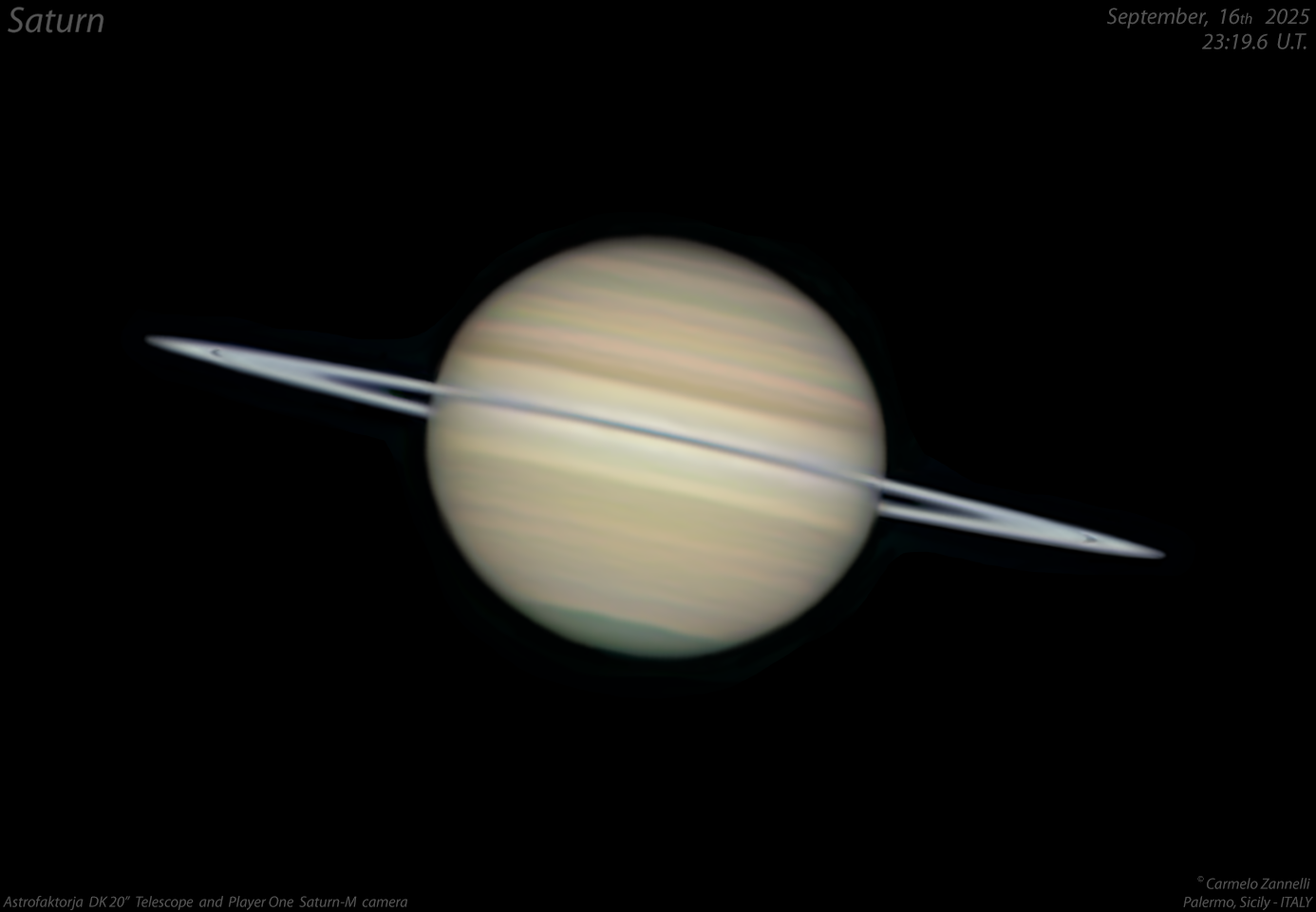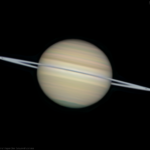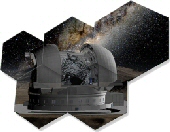Italiano: (for English, please read below)
Saturno è il sesto pianeta del sistema solare in ordine di distanza dal Sole e il secondo pianeta più massiccio, dopo Giove, con un raggio medio circa 10 volte maggiore della Terra ed è classificato come gigante gassoso, insieme a Giove, Urano e Nettuno, poiché è composto per il 95% da idrogeno e per il 3% da elio, a cui seguono gli altri esigui elementi. Il suo nucleo, consistente in ghiacci e silicati, è circondato da uno spesso strato di idrogeno metallico e quindi da uno strato esterno gassoso.
La particolarità più evidente, di chi lo osserva al telescopio, è la presenza dei suoi famosi Anelli esterni, che consistono principalmente in particelle di ghiaccio e polveri di silicati di misure che misurano da pochi millimetri a diversi metri, consistenti in milioni di piccoli oggetti ghiacciati, della grandezza che varia dal micrometro a diversi metri, tutti orbitanti attorno al pianeta sul suo piano equatoriale, e organizzati in un anello piatto. Il loro spessore medio si pensa essere pari ad appena 10 metri.
Poiché l’asse di rotazione di Saturno è inclinato rispetto al suo piano orbitale, anche gli anelli risultano inclinati.
L’origine degli anelli è ancora oggi sconosciuta, e ci sono due ipotesi principali al riguardo: che siano il risultato della distruzione di un satellite di Saturno, provocata da una collisione con una cometa o con un altro satellite, oppure che siano un “avanzo” del materiale da cui si formò Saturno che non è riuscito ad assemblarsi in un corpo unico. In passato gli astronomi pensavano che gli anelli si fossero formati assieme al pianeta miliardi di anni fa, tuttavia studi più recenti basati sui dati della sonda Cassini, che lo ha sorvolato in orbita per diversi anni, suggeriscono che l’età degli anelli non sia superiore a 400 milioni di anni.
Il momento migliore per osservare Saturno nel cielo notturno, è quando si trova più vicino alla Terra (cioè in “opposizione”), praticamente quando la Terra si trova esattamente tra il Sole e Saturno, e questo anno (2025) cadrà esattamente la notte tra il 20 ed il 21 settembre.
Questa mia ripresa, che qui vi propongo, è stata effettuata ad appena 4 giorni dal momento della “opposizione”, tuttavia è doveroso precisare che esso è ugualmente molto ben osservabile durante diverse settimane sia prima che dopo l’opposizione.
Dettagli Tecnici:
Telescopio Astrofaktoria DK20″ @ ~ F/24 – Player One Saturn M camera – Baader RGB filters – Seeing ~ 6,5/10 in R band – sito: Palermo @ my personal Observatory.
English:
Saturn is the sixth planet in the solar system from the Sun and the second most massive planet after Jupiter, with an average radius about 10 times greater than Earth. It is classified as a gas giant, along with Jupiter, Uranus, and Neptune, as it is composed of 95% hydrogen and 3% helium, followed by a small number of other elements. Its core, consisting of ices and silicates, is surrounded by a thick layer of metallic hydrogen and then by a gaseous outer layer.
The most obvious feature, observed through a telescope, is the presence of its famous Outer Rings, which consist primarily of ice and silicate dust particles ranging in size from a few millimeters to several meters. These consist of millions of small icy objects, ranging in size from micrometers to several meters, all orbiting the planet on its equatorial plane and arranged in a flat ring. Their average thickness is thought to be just 10 meters.
Because Saturn’s rotation axis is tilted relative to its orbital plane, its rings are also tilted.
The origin of the rings is still unknown, and there are two main hypotheses: either they are the result of the destruction of one of Saturn’s satellites, caused by a collision with a comet or another satellite, or they are a “leftover” of the material from which Saturn formed that failed to assemble into a single body. Astronomers previously thought the rings formed with the planet billions of years ago, but more recent studies based on data from the Cassini spacecraft, which flew past it in orbit for several years, suggest the rings are no older than 400 million years.
The best time to observe Saturn in the night sky is when it is closest to Earth (i.e., at “opposition”), essentially when the Earth is exactly between the Sun and Saturn, and this year (2025) will fall precisely on the night between September 20th and 21st.
This image, which I’m sharing here, was taken just four days after opposition. However, it’s important to note that it’s equally very well visible for several weeks both before and after opposition.
Technical Details:
Astrofaktoria DK20″ Telescope @ ~ F/24 – Player One Saturn M camera – Baader RGB filters – Seeing ~ 6.5/10 in R band – Site: Palermo @ my personal observatory.


